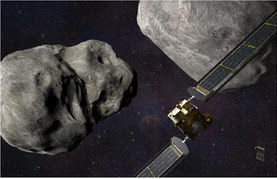Artist's conception of DART & Dimorphos
One of headlines in aftermath of DART -asteroid collision
The DART mission gurus have assured us the collision of the small spacecraft (600 lbs.) with the asteroid Dimorphos was an astounding success and we have little to worry about if Earth is again targeted like the Dinos were 65 million years ago. As one headline put it: "DART diverted an asteroid proving we have a chance against these invaders from space." But how accurate is that claim?
We now have some data to examine the outcome in more detail, and I provide some of that data below before doing calculations:
(m1) Mass of asteroid Dimorphos: 4.4 x 10 9 kg
(m2) Mass of Didymos: 5.2 x 10 11 kg
Mass of DART spacecraft: 345 kg
Eccentricity of orbit of Dimorphos around Didymos: e = 0.03
Maximum kinetic energy of DART impact with Dimorphos: 11.03 x 10 9 J
Semi-major axis of orbit of Dimorphos around Didymos: 1.19 km (pre-impact)
Semi-major axis after impact: 1.15 km
Orbital periods:
P1 = 11h 55m 18s; (pre-impact);
P2= 11h 23m ± 2m (post-impact)
The change in gravitational potential energy of orbit:
DV = m / (D a) = G (m1 + m2)/ a2 - a1
G= 6.7 x 10 -11 Nm2 / kg2
Kepler's
3rd law is required to find the new semi-major axis, viz.
(P1/ P2)2 = k(a1/ a2')3
(P1/ P2)2 = k(a1/ a2')3
We obtain, using the periods, semi-major axes:
Bear in mind we are looking at a small binary asteroid system with
the smaller (Dimorphos) making an orbit around the more massive, at an initial semi-major axis of 1.19 km.
The computations performed using the table of Dimorphos' orbital elements on Wikipedia (before and after DART impact) showed conclusively that the effect of the collision was to reduce the semi-major axis of the smaller asteroid's orbit from a1= 1.19 + 0.03 km to a2 = 1.15 (6) + 0.03 km. This data enabled the computation of the respective centripetal (orbital) velocities using:
v1 = Ö (G m2/ a1 )
v2 = Ö (G m2/ a2 )
And hence, the factor of centripetal velocity increase (1.015) - which would have led directly to the reduced -scale orbit. One problem remained in reconciling the reported (observed) kinetic energy released in the collision (11.03
x 10 9 J) with the actual calculated kinetic energy release (7.74 x 10 9 J). While perhaps half the difference may be attributed to heat generated and lost the remaining half is likely due to a 'gravity boost' taking advantage of the existing orbital energy for the system.
It is important here to understand that deflection of a small asteroid in a pre-existing (bound binary) orbit, taking advantage of its orbital (gravitational potential) energy is not the same as deflecting a (rogue) asteroid coming from 1.1 to 2.4 astronomical units distance at a max velocity of up to 30 km/s (such as the asteroid that wiped out the dinosaurs).
The conclusion is that, contrary to the media headline hype, the space jockeys at NASA have not yet proven they can "spare us the dinosaurs' fate". But it is a humble first step!
See Also:



No comments:
Post a Comment